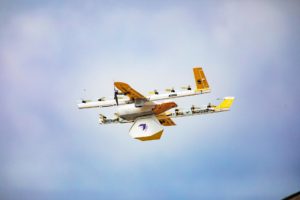
Public Opinion of Drone Delivery Depends Upon Application
Sky Limit’s research is funded by German Ministry of Education and Research, in order to inform future regulation. Overall, German citizens aren’t ready to embrace drone technology, say researchers: “The results show that most Germans oppose the use of delivery drones (55 %) and air taxis (62 %) implying a clear rejection of current proposals to develop urban airspaces for transport purposes,” says the report.
There is an exception, however. Public acceptance of drone technology seems to depend heavily upon the purpose and the perceived humanitarian or community benefits of the application. Drone delivery applications like the delivery of AED or cardiac equipment to accident scenes may need to lead the way for other more commercial missions. “Medical emergencies, however, are widely accepted: Almost two-thirds of the respondents would agree to the deployment of drones for exclusive medical use,” says the Sky Limits research.
Why Most Citizens Don’t Approve of Drone Delivery and Air Taxis
If the study doesn’t contain entirely good news for the drone industry, it provides a very clear indication of where to start in improving consumer education and alleviating community fears. Two primary concerns dominate the conversation about integrating drone technology into German communities: safety, and environmental impact. “75 % of respondents “rather” or “completely” fear that delivery drones could lead to accidents causing injuries to people- and 81 % in case of air taxis,” says the study. “Respondents overwhelmingly rated the environmental friendliness of delivery drones (79%) and air taxis (83%) as important.”
In addition to concerns about safety, most German people simply don’t see much benefit it utilizing drone technology for commercial delivery or for transportation. That could indicate that where you live – for example in a place with extreme traffic problems that interfere with both transportation and ground-based delivery – matters. But in Germany, the report finds: “…two-thirds of respondents doubt that UAV technology would be of benefit for the delivery of parcels and for passenger transport. 21 %of respondents stated that they might be willing to personally use drone deliveries, 18% would use air taxis for their individual mobility.”
Gender and age are also factors in accepting new technology. Women and respondents older than 60 years old were overall less likely to respond positively. Younger people might be more willing to give drones a chance: “Respondents in the age group between 30 and 39 years would use air taxis for their personal mobility three times more often than respondents who are older than 60 years,” says the research.
Do the Disadvantages Outweigh the Advantages for Now?
While progress has been made, large drones are still audible as they fly over communitites. That’s a problem, and Sky Limits finds it’s one of the main disadvantages that most citizens perceive in integrating drone delivery and air taxis. Additionally, many citizens are concerned that delivery drones may result in job losses in the service sector. “Overall, it appears as though respondents rated potential disadvantages of delivery drones and air taxis as more important than their advantages,” says the study.
Miriam McNabb is the Editor-in-Chief of DRONELIFE and CEO of JobForDrones, a professional drone services marketplace, and a fascinated observer of the emerging drone industry and the regulatory environment for drones. Miriam has penned over 3,000 articles focused on the commercial drone space and is an international speaker and recognized figure in the industry. Miriam has a degree from the University of Chicago and over 20 years of experience in high tech sales and marketing for new technologies.
For drone industry consulting or writing, Email Miriam.
TWITTER:@spaldingbarker
Subscribe to DroneLife here.